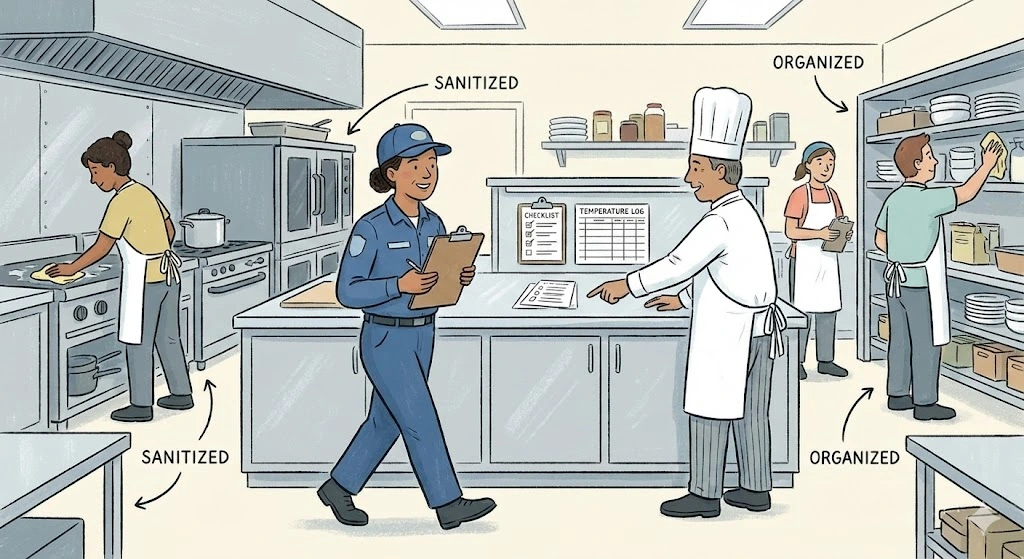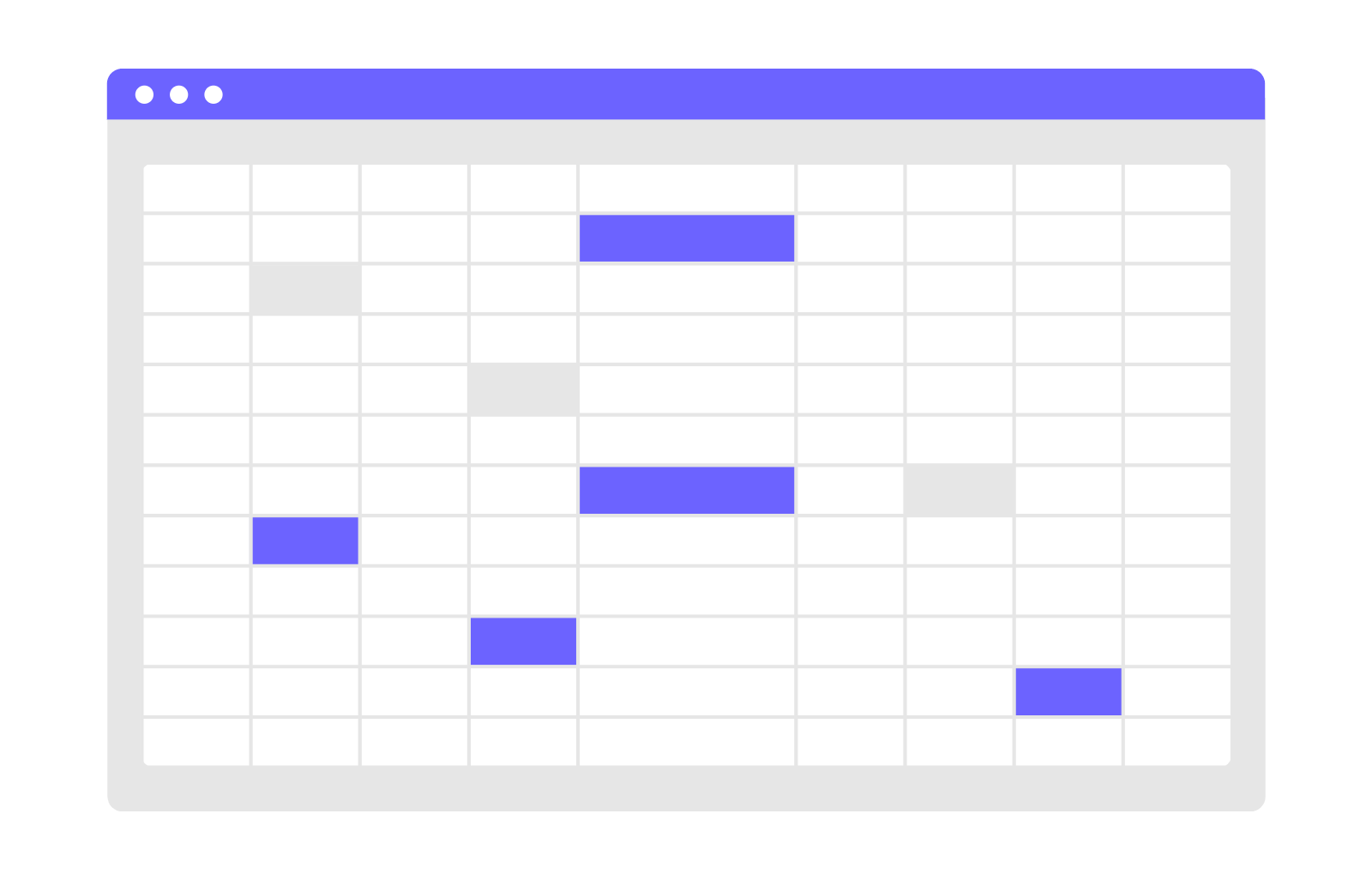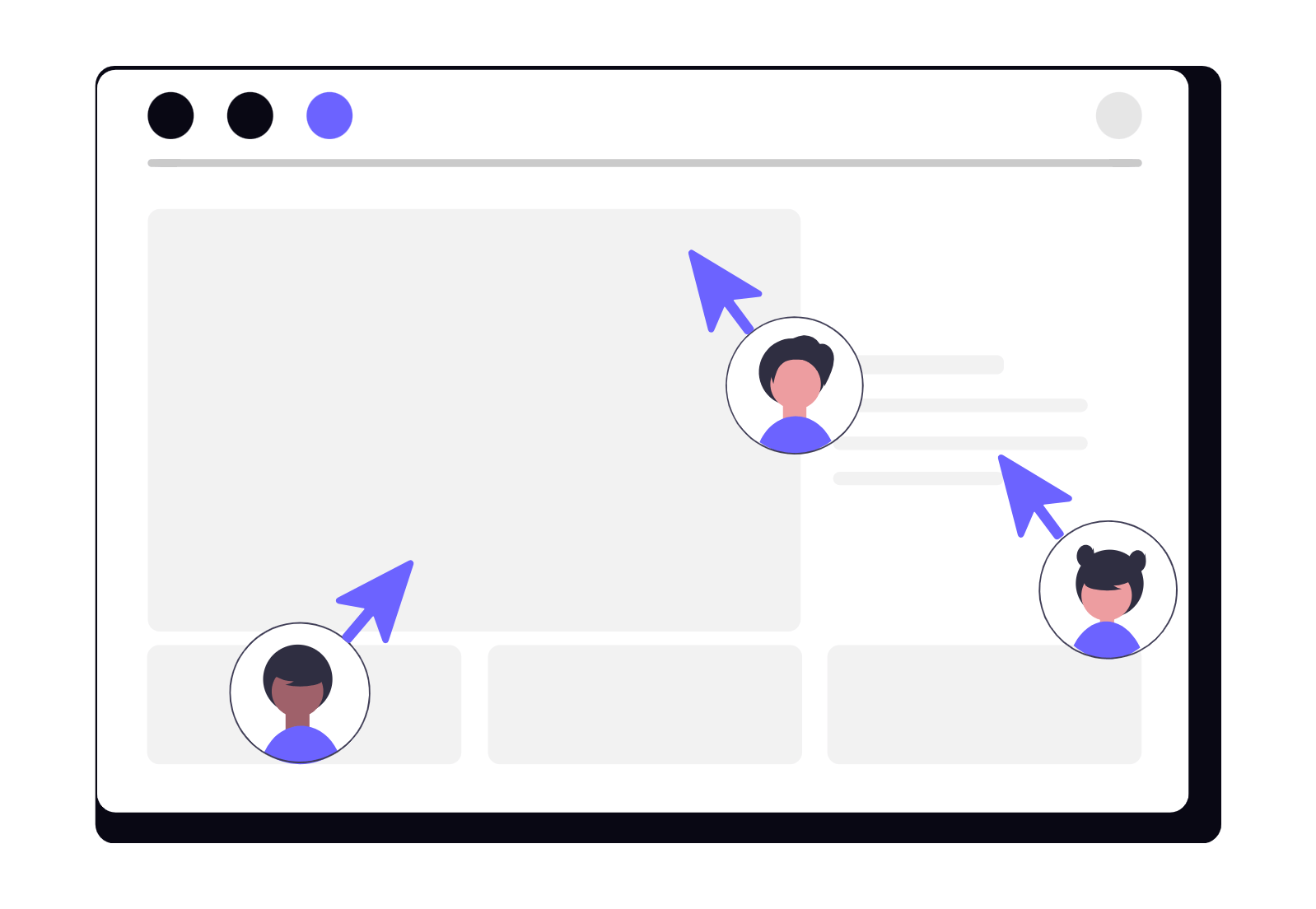How to Prepare for a Surprise Health Department Inspection
Master the art of staying inspection-ready with proven strategies that help food service businesses maintain continuous compliance, avoid violations, and pass surprise health inspections with confidence.

Aaron Kushner is an entrepreneur with decades of hands-on experience running service companies and eCommerce operations. He founded DocuStrong to solve the compliance and document-tracking challenges he faced firsthand in the field.

It’s 10:47 AM on a Tuesday. Your lunch rush is building, the kitchen is in full swing, and your phone rings. “Health inspector’s here,” your host says, voice tight with tension. Your stomach drops.

For restaurant owners and food service managers, surprise health department inspections are one of the most stressful events in business operations. Unlike scheduled audits where you can prepare and polish, unannounced visits reveal your true operational standards. One critical violation can result in closure, reputation damage, and significant financial loss.
The good news? Inspection readiness isn’t about cramming before the test-it’s about building systems that keep your operation compliant 365 days a year.
This guide covers: How surprise inspections work, the most common restaurant safety violations that lead to failures, proven strategies to build continuous compliance systems, daily monitoring procedures that keep you inspection-ready, and how technology eliminates documentation gaps that cause violations.
Key Takeaways:
- Unannounced health inspections are unavoidable, but continuous compliance significantly reduces surprise anxiety
- Maintain accurate temperature logs and enforce strict hygiene protocols daily
- Keep all certifications current with automated tracking systems
- Requirements vary by state and municipality-always confirm your local health code
- Build systems that maintain compliance automatically, not reactive crisis management
Ready to transform your inspection readiness? Start your free DocuStrong trial and get your compliance system running in under an hour.
What Are Surprise Health Inspections?
Surprise health inspections are unannounced visits by local or state health departments to evaluate food safety practices, sanitation standards, and regulatory compliance at food service establishments. These inspections occur without warning and are designed to assess your operation under normal, everyday conditions.
According to the FDA’s Retail Food Protection guidelines, health departments conduct routine inspections to protect public health by identifying and correcting food safety violations before they cause illness. Many jurisdictions inspect at least once or twice per year; some require more based on risk level. High-risk establishments or those with previous violations may see inspectors more frequently.

Health inspectors evaluate multiple critical areas during these visits: food handling and storage temperatures, employee hygiene practices, equipment maintenance, pest control, proper labeling and dating systems, and overall facility cleanliness. Many inspections last 1-2 hours, depending on facility size and issues found. The inspector documents observations and issues a report that often becomes public record.
Understanding that these inspections are inevitable-and potentially happening today-is the first step toward building a food safety compliance culture that eliminates inspection anxiety entirely.
For more insights on compliance and regulations, explore our comprehensive resource library covering everything from document management best practices to industry-specific compliance requirements.
Why Health Departments Conduct Unannounced Inspections
Health departments use surprise inspections because they reveal authentic operational practices rather than staged performances. Unannounced visits ensure inspectors see what customers actually experience.
The CDC’s Foodborne Illness Estimates report that foodborne diseases cause approximately 48 million illnesses, 128,000 hospitalizations, and 3,000 deaths annually in the United States. Food service establishments where proper protocols aren’t consistently followed contribute to these incidents.
Beyond public health protection, unannounced inspections ensure regulatory compliance, detect small issues before they escalate, provide educational opportunities for operators, and assess risk factors that determine future inspection frequency.
The randomness of timing is intentional. When you never know if today is inspection day, you’re motivated to maintain standards continuously rather than cycling between compliance and complacency.
The Most Common Health Inspector Violations
Understanding what health inspector requirements focus on helps you prepare for unannounced inspection scenarios effectively. The FDA Food Code 2022 identifies five major risk factors responsible for most foodborne illness outbreaks, and these areas receive the most scrutiny during inspections.
Most common restaurant safety violations include:
- Temperature control failures in refrigeration and hot holding
- Cross-contamination between raw and ready-to-eat foods
- Poor employee hygiene and handwashing practices
- Pest activity or inadequate pest control measures
- Missing documentation, labels, and certifications

Temperature Control Issues
Temperature violations are among the most frequently cited health code infractions. Food held at improper temperatures creates ideal conditions for bacterial growth that can cause serious illness.
Critical violations include refrigeration units running above 41°F, allowing potentially hazardous foods to enter the danger zone. Hot holding equipment failing to maintain foods at 135°F or higher also poses significant risks.
Inadequate cooling procedures that don’t bring foods from 135°F to 70°F within two hours, then to 41°F within four additional hours (total cooling time of 6 hours) violate FDA Food Code cooling requirements. Missing or inaccurate temperature logs that fail to document monitoring procedures raise red flags. Broken or uncalibrated thermometers that provide false readings compromise your entire food safety system.
Case Study: A downtown bistro received a critical violation when inspectors found their walk-in cooler fluctuating between 43°F and 47°F. The faulty thermostat caused the compressor to cycle incorrectly. The restaurant discarded over $2,000 in inventory and temporarily closed for equipment repairs.
Cross-Contamination Hazards
Cross-contamination occurs when harmful bacteria transfer from raw foods, unwashed surfaces, or contaminated equipment to ready-to-eat items.
Common violations include using the same cutting boards, knives, or preparation surfaces for raw meats and ready-to-eat foods without proper sanitization. Storing raw proteins above prepared foods in refrigeration units allows drips to contaminate items below.
Failing to wash hands between handling raw and cooked products creates dangerous transfer points. Inadequate separation in storage areas where allergens or raw products can contact finished items puts customers at risk. Reusing containers or utensils without proper washing and sanitizing compounds contamination issues.
These violations are particularly problematic because they’re not always visible to staff. A microscopic amount of raw chicken juice on a cutting board can contaminate dozens of salads throughout a shift.
Employee Hygiene Failures
Your team’s personal hygiene practices directly impact food safety. Inspectors watch for employees handling ready-to-eat foods with bare hands instead of using gloves, tongs, or other utensils.
Working while visibly ill, especially with symptoms of gastrointestinal illness, violates most health codes. Inadequate handwashing-skipping the 20-second minimum, using only water, or failing to wash after specific activities like handling raw food or touching face and hair-represents a critical risk.
Eating, drinking, or smoking in food preparation areas introduces contamination. Jewelry or false nails can harbor bacteria or fall into food. Dirty uniforms or aprons that haven’t been laundered regularly signal poor hygiene standards.
Case Study: A chain location faced closure after an inspector observed three employees preparing food after touching their phones without washing hands. After implementing a “no phones in prep areas” policy and mandatory handwashing stations at every entry point, the location achieved perfect scores.
Pest Activity and Control
Evidence of pest infestation signals serious sanitation problems and can result in immediate closure depending on the severity.
Violations include visible rodent droppings, especially in food storage or preparation areas. Live insects, particularly flies, cockroaches, or ants indicate active infestations. Gaps under doors, holes in walls, or other structural issues allow pest entry.
Missing drain covers provide access to sewer systems. Improperly stored garbage attracts pests. Lack of professional pest control documentation suggests inadequate preventive measures.
Pest infestations often develop gradually before becoming visible. Preventive maintenance and regular professional pest control services help address issues before they become serious violations.
Documentation and Labeling Failures
Proper documentation demonstrates your commitment to food safety protocols and helps trace problems if illness occurs.
Common violations include missing date labels on prepared foods, preventing proper rotation. Incomplete temperature logs showing gaps in monitoring raise questions about actual practices. Expired permits or certifications not displayed as required violate regulations.
No documentation of cleaning schedules or maintenance procedures suggests inconsistent practices. Missing allergen information or ingredient lists puts customers at risk. Undocumented employee training records make it impossible to verify food safety knowledge.
These “paperwork violations” might seem minor compared to temperature or contamination issues, but they indicate weak operational systems. If you’re not documenting procedures, are you actually following them consistently?

Automated tracking systems, like DocuStrong, can ensure every certification, permit, and temperature log stays current without relying on memory. These systems send alerts when documentation isn’t completed and provide real-time visibility into what needs attention before inspectors arrive.
Don’t let documentation gaps put your business at risk. Get started with DocuStrong today and build bulletproof compliance documentation.
How to Build a Continuous Compliance System
The secret to passing surprise inspections isn’t last-minute panic cleaning-it’s establishing operational systems that maintain compliance automatically, regardless of who’s working or when inspectors arrive.
Key components of effective restaurant inspection checklist systems:
- Documented standard operating procedures for every food safety process
- Daily monitoring checklists with accountability measures
- Proactive equipment maintenance schedules
- Continuous staff training and reinforcement
- Regular internal mock inspections

Establish Clear Standard Operating Procedures
Document every food safety process in writing. Your SOPs should cover opening and closing procedures, receiving protocols, storage procedures including FIFO rotation, cooking temperatures for every menu item, and cleaning schedules with specific chemical concentrations.
Make these procedures visual and accessible. Laminated quick-reference guides posted at relevant stations work better than binders nobody reads.
Implement Daily Checklists and Monitoring Logs
Checklists transform abstract standards into concrete daily actions. Create station-specific checklists that verify refrigeration temperatures, inspect equipment, verify sanitizer concentration, and check supply inventory.
The power of checklists is creating accountability and documentation. When every shift leaves a paper trail, you can identify problems early and demonstrate compliance to inspectors. DocuStrong’s expiration tracking automates this documentation burden, sending alerts when logs aren’t completed.
Create a Maintenance and Repair Response Protocol
Equipment failures can lead to health code violations. Schedule preventive maintenance for all critical equipment. Create rapid response plans for failures, including backup suppliers and after-hours repair services. Test temperature monitoring devices weekly.
Case Study: A catering company maintained meticulous temperature logs for months. During an inspection, the health inspector tested their probe thermometer and discovered it read 8°F too high. Everything they thought was safe at 135°F was actually at 127°F. The violation resulted in discarding that day’s production.
Train Staff Continuously, Not Just at Onboarding
Food safety knowledge degrades without reinforcement. Conduct mandatory food handler certification for all staff, monthly refresher training on critical topics, and pre-shift meetings addressing relevant food safety issues. Post visual reminders throughout the kitchen and conduct regular competency checks.

Conduct Internal Mock Inspections
The best preparation is conducting your own surprise inspections. Have managers perform detailed inspections using the same forms local health departments use. Vary the timing across different shifts and days. Photograph violations for training examples.
Transform your compliance approach from reactive to proactive. Join thousands of businesses using DocuStrong to maintain continuous compliance confidence.
How to Stay Inspection-Ready Every Day
When surprise becomes routine, anxiety disappears. These daily practices keep your operation ready to pass a health department inspection at any moment.
Morning Opening Procedures
Start every day with systematic checks. Verify and record temps in all refrigeration and hot holding units before production begins. Address anything out of range immediately.
Turn on and test all cooking equipment, ventilation systems, and dishwashers. Confirm sanitizer dispensers are filled and at proper concentration. Verify adequate supplies of gloves, hand soap, sanitizer, and thermometers.
Review all prepared items for proper labeling and check dates against discard schedules. Remove anything expired or improperly labeled. Do a quick walk-through for obvious cleanliness issues.
Mid-Shift Monitoring
Maintaining standards during busy periods prevents the most common violations. Assign someone to monitor handwashing compliance, especially after handling raw proteins. Check food temperatures every two hours during holding periods and record them immediately.
Monitor hot and cold line organization to ensure proper separation. Empty trash regularly to prevent overflow. Verify sanitizer concentration hourly.
Closing Protocols
Complete and document all cleaning tasks-ovens, grills, prep surfaces, floor drains. Properly store and label all prepared foods with use-by dates. Take final temperature readings and record them.
Inspect for pest activity behind equipment and in storage areas. Secure all chemicals in designated storage. Document any equipment issues for follow-up.
How Technology Streamlines Compliance Management
Manual compliance management-paper checklists, filing cabinets full of certifications, sticky notes reminding you about permit renewals-creates gaps where violations develop. Modern compliance technology helps reduce these risks.

Digital document management systems centralize all your compliance documentation in one secure, searchable location. Instead of scrambling to find employee certifications or maintenance records when an inspector asks, you can pull them up instantly on any device.
Automated reminder systems ensure nothing expires without warning. Set alerts for employee food handler certifications expiring in 30 days, equipment maintenance due within 7 days, or permit renewals requiring applications 60 days in advance. Track temperature log gaps indicating missed monitoring and cleaning schedules falling behind.
Advanced compliance tracking provides real-time visibility into your operation’s readiness status. Dashboard views show exactly which certifications are current, which need attention, and where your vulnerabilities exist. This transforms reactive crisis management into proactive prevention.
Case Study: A multi-location restaurant group struggled with inconsistent inspection results. Some locations consistently scored 95+, while others received critical violations quarterly. After implementing centralized compliance management, they discovered the pattern: high-performing locations had managers who tracked every certification in detailed spreadsheets. By standardizing digital systems with automated reminders and escalations, they brought every property to consistent high performance within six months.
Ready to eliminate compliance gaps? Start your free trial and get complete visibility into your compliance status.
What to Do During a Health Department Inspection
Your behavior during an inspection can significantly impact the outcome. Greet the inspector professionally, verify their credentials, and notify your manager immediately. Offer to accompany them and avoid defensive behavior.
Answer questions honestly-lying makes violations worse. Take notes on all comments, not just written violations. If you can safely correct minor issues immediately while the inspector is present, doing so demonstrates your commitment to compliance.
When violations are identified, listen carefully and ask for guidance on correct procedures. Review the inspection report thoroughly before signing. Understand the difference between critical violations (immediate health risks) and non-critical issues.
After the inspector leaves, share the report with your management team and address critical violations immediately. Document all corrective actions and use violations as training opportunities.
Restaurant Inspection Checklist: Daily Verification
Use this comprehensive checklist for daily verification of your operation’s inspection readiness. Download this checklist as a printable PDF for your kitchen staff to ensure consistent compliance across all shifts.

Temperature Control:
- All refrigeration units between 32°F and 41°F
- All hot holding equipment at 135°F or higher
- Temperature logs complete with no gaps
- All thermometers calibrated and functioning
Food Storage and Handling:
- All items properly labeled with contents and dates
- FIFO rotation clearly visible in storage areas
- Raw proteins stored below ready-to-eat foods
- No items stored on floor or in contact with walls
Personal Hygiene:
- All handwashing stations stocked with soap and towels
- Employees wearing clean uniforms and hair restraints
- No bare-hand contact with ready-to-eat foods
- Employee health policy posted and followed
Sanitation and Cleanliness:
- All food contact surfaces clean and sanitized
- Sanitizer concentration verified and logged
- Floors, walls, and ceilings clean and in good repair
- Garbage areas clean, covered, and pest-free
Equipment and Facilities:
- All equipment clean and functioning properly
- Adequate lighting throughout facility
- Ventilation systems operating effectively
- Doors and windows sealed against pest entry
Documentation and Permits:
- Food service permit current and displayed
- All employee food handler certifications current
- Maintenance logs complete and accessible
- Pest control service documentation available
This checklist should become second nature-a mental routine you complete automatically every shift. Automated compliance tracking systems can digitize this checklist and provide instant visibility into any incomplete items.
Start Your Free Trial - No credit card required. Get your compliance system up and running in under an hour.
Frequently Asked Questions About Health Inspections
How often will my restaurant be inspected?
Inspection frequency varies by jurisdiction and risk factors. Many jurisdictions inspect at least once or twice per year; some require more based on risk level. High-risk establishments may see inspectors quarterly or even monthly.
Requirements vary by state and municipality-always confirm your local health code. Contact your local health department to understand their specific schedule and risk factors that might increase your inspection frequency.
Can I refuse entry to a health inspector?
While you technically can refuse entry, doing so is rarely advisable. Refusing inspection is often grounds for immediate permit suspension and facility closure under most health codes, in addition to prompting an administrative warrant and law enforcement response. It also creates suspicion and can trigger more thorough scrutiny when inspectors do gain access.
The professional approach is to always accommodate inspectors and cooperate fully.
What happens if I fail a health inspection?
Outcomes depend on violation severity. Non-critical violations typically require correction within a timeframe set by your local health department, with documentation of remediation. Critical violations may require immediate correction, temporary closure, or mandatory follow-up inspection within days.
Multiple violations can result in permit suspension, fines, mandatory training, or permanent closure in severe cases. Most jurisdictions publish inspection scores publicly, impacting your reputation. Address violations immediately and document all corrective actions.
How can I prepare my staff for surprise inspections?
Build daily habits that maintain continuous compliance. Train all staff during onboarding, then reinforce key concepts in pre-shift meetings. Conduct monthly refresher training on topics like handwashing, temperature control, and cross-contamination prevention.
Create visual reminders throughout your facility and model perfect compliance yourself-staff follow leadership example. Automated training reminders and certification tracking ensure no staff member falls through the cracks.
Should I correct issues during the inspection or wait until after?
If you can safely correct a minor issue immediately, doing so demonstrates your commitment to compliance. For example, immediately correcting an improperly dated container shows responsiveness. Some inspectors may note this positively, though practices vary by jurisdiction.
Never compromise safety or attempt repairs you’re not qualified for. Critical violations requiring equipment repairs or pest control can’t be fixed on the spot-explain your planned corrective action and timeline instead.
How do I know if my restaurant is ready for a surprise inspection?
Your restaurant is ready when you can confidently answer “yes” to these questions: Are all temperature logs current? Are employee certifications up to date? Can you produce required documentation within 60 seconds?
The best test is conducting your own unannounced internal inspections using the same inspection forms your local health department uses. Contact your local health department to obtain their inspection checklist forms. If you’re passing your own surprise inspections consistently, you’re ready for the real thing.
Take Control of Your Compliance Today
Surprise health inspections don’t have to trigger panic. When you build systems that maintain compliance continuously, inspection readiness becomes your default operating state rather than a frantic preparation ritual.

The foundation is simple: documented procedures, daily monitoring, continuous training, and technological tools that automate reminder and tracking processes. These systems protect public health, safeguard your reputation, prevent costly violations, and create peace of mind that your operation meets professional standards regardless of when inspectors arrive.
Ready to improve your inspection readiness? Explore how DocuStrong’s automated tracking, intelligent reminders, and centralized documentation help reduce the gaps where violations develop. Our platform helps food service operators maintain continuous inspection readiness without drowning in paperwork.
Start your free trial today and transform surprise inspections from anxiety-inducing events into routine confirmations of the high standards you maintain every single day.
Or explore all DocuStrong features to see how we solve the specific compliance challenges your business faces.
For a comprehensive overview of document management and compliance, see our complete guide: Document Management and Compliance: The Complete Guide. Stop leaving compliance to chance. Build the system that protects your business, your team, and your peace of mind. Visit our homepage to learn more about how DocuStrong transforms compliance management for businesses of all sizes.
Related Articles

The Ultimate Compliance Checklist for Small Business Owners
A comprehensive guide to building and maintaining your business compliance program. Learn what documents you need, when to renew them, and how to avoid costly penalties with proven strategies from industry experts.

What Happens When Your Business License Expires? (And How to Avoid It)
An expired business license can halt operations, trigger fines up to $10,000, and damage your reputation. Learn what happens when licenses expire, how to prevent it, and why automated tracking is essential for compliance.

7 Compliance Mistakes That Cost Businesses Thousands (and How to Avoid Them)
Discover the most frequent compliance errors that lead to fines, operational disruptions, and reputational damage-plus practical strategies to prevent them before they impact your bottom line.
